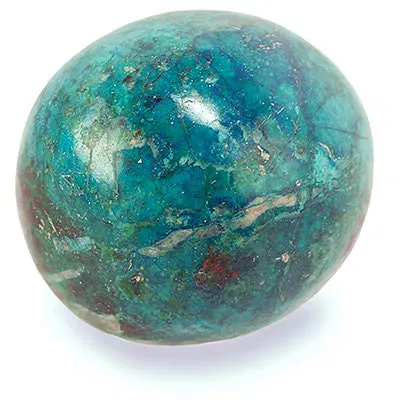 Chrysocolla is a hydrous copper silicate, a minor copper ore that was first referenced in 315 BC, in the writings of Theophrastus. The name chrysocolla comes from the Greek word chrysos meaning gold and kola for glue, as it resembles other materials including borax, which was used as a flux in soldering gold in ancient times. Chrysocolla is mainly found in copper mines in dry areas, such as in the Southwest areas of the United States. Sometimes chrysocolla resembles
Chrysocolla is a hydrous copper silicate, a minor copper ore that was first referenced in 315 BC, in the writings of Theophrastus. The name chrysocolla comes from the Greek word chrysos meaning gold and kola for glue, as it resembles other materials including borax, which was used as a flux in soldering gold in ancient times. Chrysocolla is mainly found in copper mines in dry areas, such as in the Southwest areas of the United States. Sometimes chrysocolla resembles ![]() turquoise, and is used as an alternate to the stone.
turquoise, and is used as an alternate to the stone.
 In the 1950's, US lapidaries voted chrysocolla-colored
In the 1950's, US lapidaries voted chrysocolla-colored ![]() chalcedony the most popular American gem. Chrysocolla is translucent to almost opaque, and can be sky blue, greenish blue, or green. It is a brittle stone, and quite soft, rating only a 2-4 on the hardness scale. Because of this, chrysocolla is fragile and tends to break easily when exposed to the atmosphere. However, intermixture with
chalcedony the most popular American gem. Chrysocolla is translucent to almost opaque, and can be sky blue, greenish blue, or green. It is a brittle stone, and quite soft, rating only a 2-4 on the hardness scale. Because of this, chrysocolla is fragile and tends to break easily when exposed to the atmosphere. However, intermixture with ![]() quartz or chalcedony gives the stone more durability. Lapidaries can polish the stone in a way that accentuates the colored chrysocolla as well as the sparkles of quartz within. Chrysocolla is often cut as beautiful greenish-blue cabochons, and used for ornaments such as carvings and figurines. High quality, translucent, gem quality chrysocolla is extremely rare and highly prized.
quartz or chalcedony gives the stone more durability. Lapidaries can polish the stone in a way that accentuates the colored chrysocolla as well as the sparkles of quartz within. Chrysocolla is often cut as beautiful greenish-blue cabochons, and used for ornaments such as carvings and figurines. High quality, translucent, gem quality chrysocolla is extremely rare and highly prized.
 Chrysocolla occurs in copper veins and is formed by waters containing silica. It forms as crusts, stalactites or stalagmites, and in botryoidal (grapelike) shapes, as well as inclusions in other minerals. It is often mixed with copper compounds and is associated with such minerals
Chrysocolla occurs in copper veins and is formed by waters containing silica. It forms as crusts, stalactites or stalagmites, and in botryoidal (grapelike) shapes, as well as inclusions in other minerals. It is often mixed with copper compounds and is associated with such minerals ![]() quartz, azurite,
quartz, azurite, ![]() turquoise, limonite, cuprite, tenorite, hematite, and malachite. Chrysocolla is also very similar to malachite but is of a deeper shade of blue. The mottled blue and green varieties of chrysocolla come from Arizona, California, New Jersey, Michigan, New Mexico, Utah, and Pennsylvania. Large deposits are also found in Wanlockhead, Dumfries and Galloway Scotland; Chihuahua in Mexico; South Australia, Australia; Alsace, France, various locations in Israel and Chile, and in the Shaba province in the Democratic Republic of Congo.
turquoise, limonite, cuprite, tenorite, hematite, and malachite. Chrysocolla is also very similar to malachite but is of a deeper shade of blue. The mottled blue and green varieties of chrysocolla come from Arizona, California, New Jersey, Michigan, New Mexico, Utah, and Pennsylvania. Large deposits are also found in Wanlockhead, Dumfries and Galloway Scotland; Chihuahua in Mexico; South Australia, Australia; Alsace, France, various locations in Israel and Chile, and in the Shaba province in the Democratic Republic of Congo.
 Chrysocolla is a stone known for helping people; women in particular . It supposedly aids in the emotional healing from incest and rape. It also heals physical ailments of the lungs, throat, and heart, as well as helps to alleviate female problems such as premenstrual syndrome, cramps and inflammations. Chrysocolla creates a strong awareness of the self. It releases grief, sadness and a fear of negative emotions. It aids in attaining joy, certainty and peace by supporting letting go, and surrendering to pain and worry.
Chrysocolla is a stone known for helping people; women in particular . It supposedly aids in the emotional healing from incest and rape. It also heals physical ailments of the lungs, throat, and heart, as well as helps to alleviate female problems such as premenstrual syndrome, cramps and inflammations. Chrysocolla creates a strong awareness of the self. It releases grief, sadness and a fear of negative emotions. It aids in attaining joy, certainty and peace by supporting letting go, and surrendering to pain and worry.